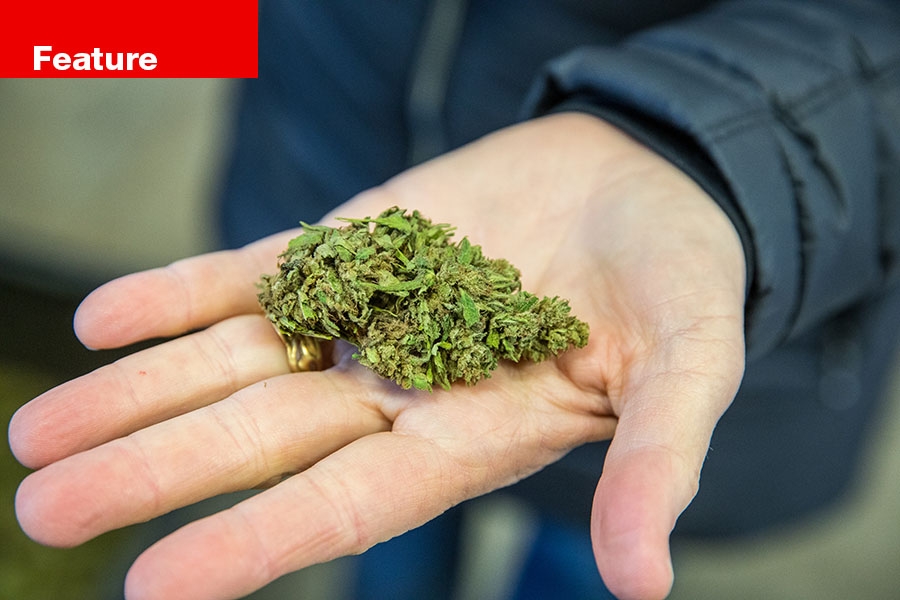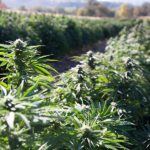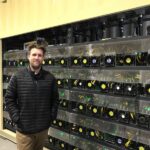The hemp-farming boom of 2018 created financial hardships for those who failed to turn a profit. But innovation and easing of regulations could open new doors for farmers.
Jay Noller, director of the Global Hemp Innovation Center at Oregon State University, has taken three trips to China to study the use of hemp in fabrics. Oregon State University’s innovation center is the largest in the country.
Noller says his research in China will help to make hemp grown in the Pacific Northwest more suitable for use in textiles.
The trips to China are part of the research center’s efforts to find new industrial uses for the plant. The market is in desperate need of diversification. Nearly all of the state’s hemp, a strain of the cannabis plant, is processed into cannabidiol (CBD) oil, which is touted as a natural remedy for common ailments.
The sector is oversaturated with growers, which are all dependent on similar supply chains.
The Global Hemp Innovation Center connects students and faculty members with other plant researchers, food innovators, pharmacies, businesses and engineers across the globe to experiment with different strains of hemp and develop new uses for the plant.
“People have been growing this stuff in their basement for so long, we haven’t really been able to experiment with it,” says Noller. “Everyone has been using the same recipe; it’s become about who can have the best version of that recipe. There’s a lot of room to experiment with different ways of growing hemp.”
The climate of the Pacific Northwest is uniquely well-suited to growing hemp. This explains the market’s explosive growth after the 2018 Farm Bill passed. The legislation classified the plant as a federally legal crop, and growers piled into the sector.
Many cultivators came from the marijuana sector, which was perceived as an overcrowded market. A 2018 report by the Oregon Liquor Control Commission stated cannabis growers had produced enough product to satisfy demand for six years.
“A lot of marijuana farmers switched over to hemp because the market was saturated and they saw an opportunity,” says Peter Koch, owner of hemp producer Whole Circle Farms in Silverton. The farm was one of the first cultivators of hemp in the state. Koch and his wife, Rochelle, planted their first crop of hemp in 2016, when 83 people had grower licenses.
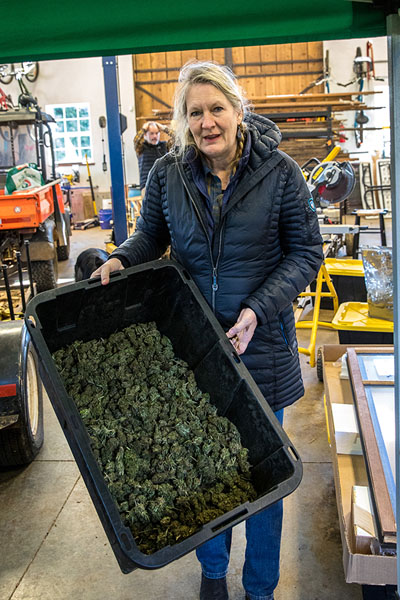 Rochelle Koch with harvested hemp. Photo by Jason E. Kaplan
Rochelle Koch with harvested hemp. Photo by Jason E. Kaplan
Oregon legalized hemp in 2015, but it was still illegal at the federal level when the Kochs started their farm. The passage of the 2018 Farm Bill meant hemp-derived products could be sold in stores, which meant more buyers.
Today there are 1,961 licensed cultivators in Oregon. Acreage devoted to growing hemp also exploded. In 2017 there were 3,000 acres of hemp farming in Oregon. In 2019 that amount had swelled 20 times that number to 63,883 acres.
RELATED STORY: Glut Check
“Now the same thing that happened to the marijuana market has happened to the hemp market,” says Koch.
“It was like the Gold Rush,” says a farmer from Southeastern Oregon, who chose to remain anonymous. “We couldn’t buy everything we needed when we needed it. Everything was sold out. When we needed to call people to come fix something or look at something, their schedules were filled three weeks out.”
Those gold-rush days could soon be over as the market matures and research and development institutions find new uses.
The textile industry is one of the most promising uses for the plant. Hemp has gained popularity in some corners of the fashion industry for its sustainability benefits. Not only is hemp a robust plant that does not require much water or pesticides, the roots of the hemp plant can remove contaminants from the soil in a process known as phytoremediation.
Jessica Davis, who handles public relations for clothing company Toad&Co, says using hemp materials fits into the company’s mission of sustainability. The firm doubled its hemp purchasing between 2018 and 2019, and plans to maintain or increase its intake in 2020.
Clothing manufacturers such as Patagonia have begun to use hemp fiber in their clothing lines. The bad news for Oregon growers is that clothing companies source their hemp from China, where the crop is nationally subsidized.
Toad&Co would “absolutely” consider sourcing hemp domestically, says Davis, once “the fiber, yarn and fabric production evolves to the right commercial level.”
Noller remarks how China is really the expert on growing hemp for fiber for textiles. “You can’t just grow a hemp plant and make blue jeans or parkas out of it. It’s a highly specific process,” he says.
“China had a national research program that looked at the characteristics of what is grown and how to separate the fibers into the materials.”
In addition to being an earth-friendly crop, hemp may receive attention from sustainability-minded companies for its ability to substitute for petroleum and forestry products.
“We have a group looking into construction possibilities,” says Noller. “There is ‘hempcrete,’ where hemp is used as an aggregate [particulate matter used in construction]. Also, hemp is being used as a binder in building materials, and as the fiber and the binder for wood-like products like paneling and furniture.”
Hemp fiber has already been used for 3D printing by Oregon State University’s College of Forestry, he adds.
A number of faculty are researching how hemp can be used in electronics and energy storage. Hemp can also be used in wiring and as a battery source.
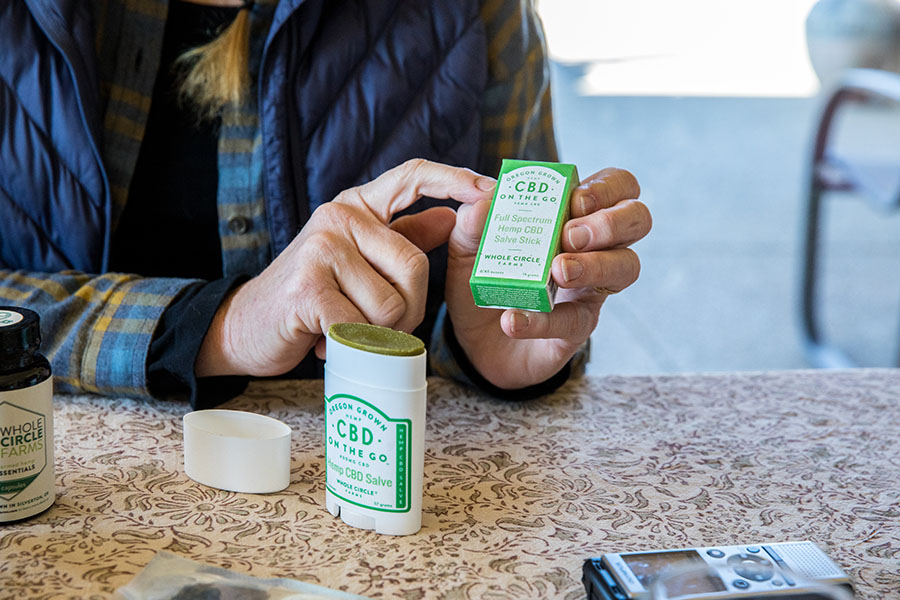 A selection of items produced using Whole Circle Farms hemp. Photo by Jason E. Kaplan
A selection of items produced using Whole Circle Farms hemp. Photo by Jason E. Kaplan
The innovation possibilities could lead to a bright economic future for the plant, but Noller says a new spike in demand will take time.
“Companies want to see that hemp can be grown consistently, and the fact is there just hasn’t been much hemp grown in the United States yet,” he says. “There’s a three- to five-year window before these markets can start to come online.”
In the short term, however, legislative bodies in conjunction with innovators could provide relief to struggling hemp farmers.
Hemp faces strict regulations when it comes to the total amount of tetrahydrocannabinol (THC), the psychoactive constituent of cannabis, that can be present in the plant.
Upon federal legalization, the Food and Drug Administration declared any hemp plant containing more than 0.3% THC illegal. This standard is based on obsolete scientific research, says Noller.
Additionally, the use of hemp as animal feed is illegal in the U.S., which is not the case in European countries, such as the Netherlands.
The research center is collaborating with Oregon State University’s veterinary-science department to test whether or not properties from hemp carry forward in milk and meat when used as feed. With enough research, the Food and Drug Administration’s ban on hemp-based feed in the U.S. could come to an end.
While the hemp industry experiences growing pains, growers who weather the green gold rush could see dividends as hemp research in the state yields results.
“It’s the kind of thing that will appear to be an overnight success in 10 to 15 years,” says Noller.
To subscribe to Oregon Business, click here.


